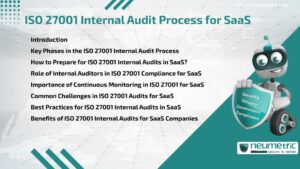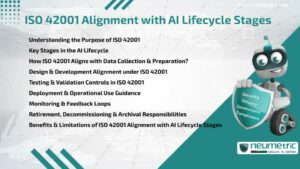Table of Contents
ToggleIntroduction
Achieving ISO 27001 Certification is a significant milestone for any organisation aiming to establish a strong Information Security Management System [ISMS]. However, before diving into the Certification Process, businesses should first conduct an ISO 27001 Readiness Assessment to identify gaps, assess Risks & prepare effectively. This article explains the key steps, benefits & challenges associated with an ISO 27001 Readiness Assessment to help organisations streamline their certification journey.
Understanding ISO 27001 Readiness Assessment
An ISO 27001 Readiness Assessment is a preliminary evaluation that helps organisations determine their current Compliance level with ISO 27001 standards. It involves Reviewing Policies, procedures & Security Controls to identify Gaps before undergoing a formal Certification Audit.
Unlike a Certification Audit, which determines full Compliance, a Readiness Assessment is a proactive approach that provides insights into areas requiring improvement. Organisations that undergo this assessment can mitigate Risks, address Vulnerabilities & enhance their Security Posture.
Key Steps in Conducting ISO 27001 Readiness Assessment
1. Define Scope & Objectives
Establish the scope of the ISO 27001 Readiness Assessment by identifying Critical Assets, Business processes & Security Controls that fall under the ISMS Framework.
2. Conduct a Gap Analysis
Compare existing Security Policies & Procedures with ISO 27001 requirements. Identify discrepancies & document areas that need improvement.
3. Risk Assessment & Management
Evaluate potential security Risks, their impact & the Likelihood of occurrence. Implement Risk treatment plans based on the assessment findings.
4. Review Documentation & Policies
Ensure all Security Policies, Controls & Procedures align with ISO 27001 requirements. This includes reviewing Access Control, Incident Response & Business Continuity Plans.
5. Perform Internal Audits
Conduct Internal Audits to assess how well Security Controls are implemented. This Step helps in identifying weaknesses before the formal Certification Audit.
6. Employee Training & Awareness
Educate Employees on ISO 27001 principles, security Best Practices & Compliance Requirements. Well-informed staff play a crucial role in maintaining an effective ISMS.
7. Prepare a Readiness Report
Summarise findings, list Gaps, suggest Corrective Actions & Outline Next Steps for full ISO 27001 Certification Readiness.
Benefits of an ISO 27001 Readiness Assessment
- Early Detection of Compliance Gaps – Identifies weaknesses before the formal Audit.
- Cost & Time Efficiency – Reduces the Risk of failing the Certification Audit, saving Time & Resources.
- Improved Security Posture – Strengthens Data protection & minimizes Vulnerabilities.
- Regulatory & Client Confidence – Demonstrates commitment to Information Security, improving trust among Stakeholders.
Common Challenges & How to Overcome Them
1. Lack of Internal Expertise
Many organisations struggle with understanding ISO 27001 requirements. Solution: Engage Consultants or use Online Resources to build Expertise.
2. Resistance to Change
Employees may resist new Security Policies. Solution: Provide Training & Highlight the importance of ISO 27001 Compliance.
3. Incomplete Documentation
.Missing Policies & Procedures can delay readiness. Solution: Conduct thorough Documentation Reviews & Update Policies accordingly.
ISO 27001 Readiness Assessment vs. Full Certification Audit
| Aspect | Readiness Assessment | Certification Audit |
| Purpose | Identifies Gaps & Areas for improvement | Determines full Compliance with ISO 27001 |
| Conducted By | Internal Team or External Consultant | Accredited Certification body |
| Outcome | Readiness Report with recommendations | Certification decision |
Tools & Resources for ISO 27001 Readiness Assessment
- ISO 27001 Gap Analysis Tools – Helps in identifying Compliance Gaps.
- Risk Assessment Software – Supports evaluating & mitigating Security Risks.
- ISO 27001 Checklist – Provides a structured approach to Compliance.
Who needs an ISO 27001 Readiness Assessment?
- Organizations Seeking ISO 27001 Certification – Ensures a smooth Certification process.
- Businesses Handling Sensitive Data – Protects Client & Corporate Information.
- Companies in Regulated Industries – Meets Compliance requirements for Security Standards.
How to get Started with ISO 27001 Readiness Assessment?
- Assign a dedicated Team for the Assessment.
- Use structured Tools & Checklists to evaluate Compliance.
- Engage ISO 27001 experts for Professional Guidance.
- Address identified Gaps before scheduling the Certification Audit.
Conclusion
An ISO 27001 Readiness Assessment is a crucial step for organisations aiming to achieve Certification. It identifies security Gaps, strengthens Compliance & ensures a smooth transition into the formal Audit process. By following the Outlined Steps & Best Practices, Businesses can enhance their Information Security Framework & improve their overall Compliance readiness.
Takeaways
- An ISO 27001 Readiness Assessment identifies Gaps before the Certification Audit.
- Key steps include Gap Analysis, Risk Assessment, Documentation Review & Internal Audits.
- Benefits include improved Security, Cost efficiency & enhanced Stakeholder confidence.
- Common challenges include lack of Expertise, Resistance to change & incomplete Documentation.
- Organizations can use Tools, Training & Expert Consultations to streamline their Assessment process.
FAQ
What is an ISO 27001 Readiness Assessment?
An ISO 27001 Readiness Assessment is a Preliminary evaluation that helps organisations determine their preparedness for ISO 27001 Certification.
How does an ISO 27001 Readiness Assessment differ from a Certification Audit?
A Readiness Assessment identifies Compliance Gaps, while a Certification Audit is a formal evaluation by an Accredited body to determine ISO 27001 Certification eligibility.
Why is an ISO 27001 Readiness Assessment important?
It helps organisations identify weaknesses, improve Security Measures & ensure Compliance before undergoing a formal Audit.
How long does an ISO 27001 Readiness Assessment take?
The duration varies based on the organisation’s size & existing Security Posture, but it typically takes a few weeks to a couple of months.
Can a Company perform an ISO 27001 Readiness Assessment Internally?
Yes, companies can conduct Internal Assessments using Checklists & Gap Analysis Tools, but External Consultants can provide additional expertise.
What are the Key Steps in an ISO 27001 Readiness Assessment?
Steps include Defining Scope, Conducting Gap Analysis, performing Risk Assessment, Reviewing Documentation, running Internal Audits & Training Employees.
Do all Businesses need an ISO 27001 Readiness Assessment?
While not mandatory, it is highly recommended for organisations seeking ISO 27001 Certification or those handling Sensitive Information.
What are the Common Challenges in Conducting an ISO 27001 Readiness Assessment?
Challenges include lack of Expertise, resistance to Change & incomplete Documentation, which can be overcome with proper Training & Resources.
How can Businesses get started with an ISO 27001 Readiness Assessment?
They can begin by assigning a dedicated Team, using structured Checklists, engaging Experts & addressing identified Gaps before the Certification Audit.
Need help?
Neumetric provides organisations the necessary help to achieve their Cybersecurity, Compliance, Governance, Privacy, Certifications & Pentesting goals.
Organisations & Businesses, specifically those which provide SaaS & AI Solutions, usually need a Cybersecurity Partner for meeting & maintaining the ongoing Security & Privacy needs & requirements of their Clients & Customers.
SOC 2, ISO 27001, NIST, HIPAA, HECVAT, EU GDPR are some of the Frameworks that are served by Fusion – a centralised, automated, AI-enabled SaaS Solution provided by Neumetric.
Reach out to us!





